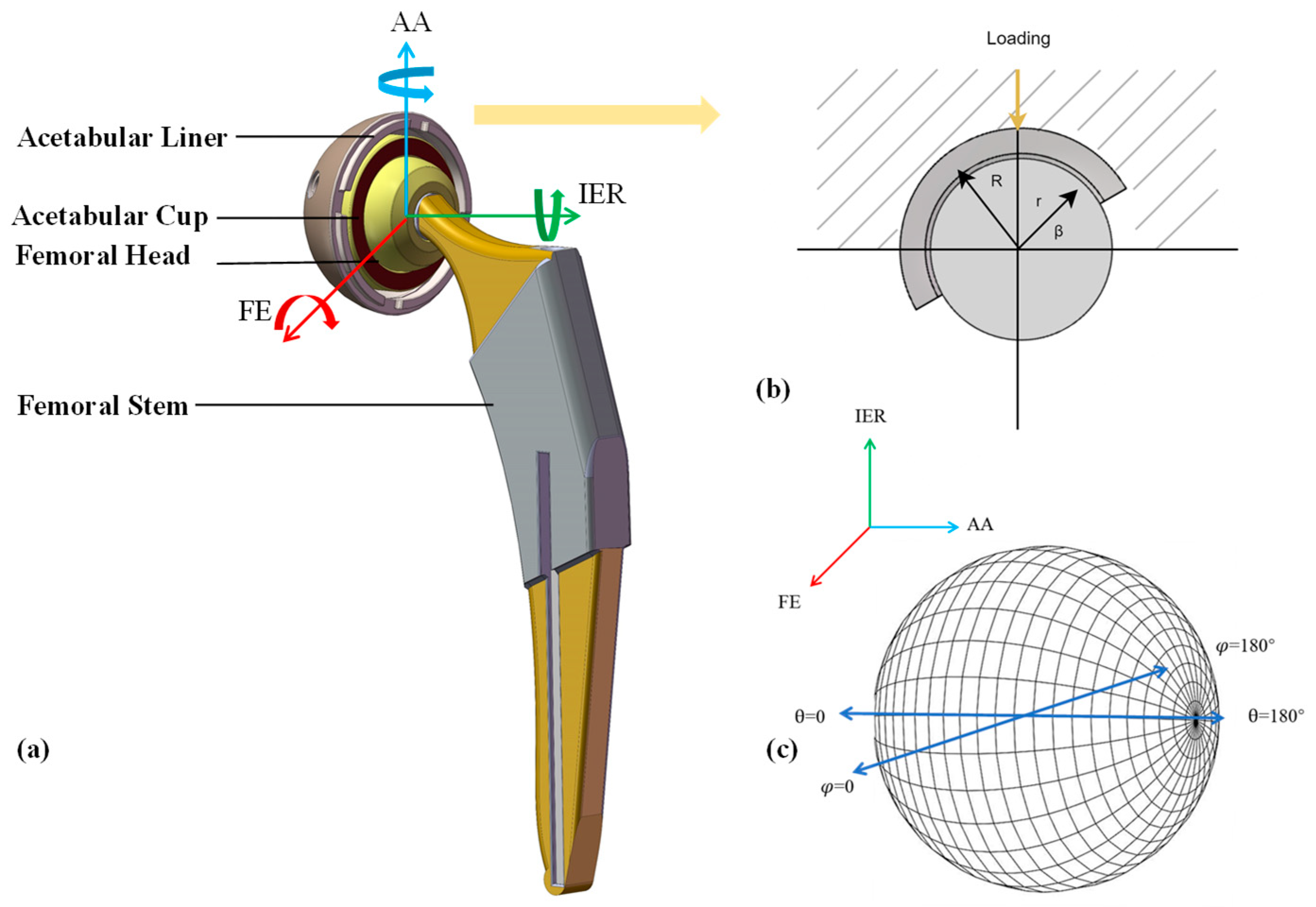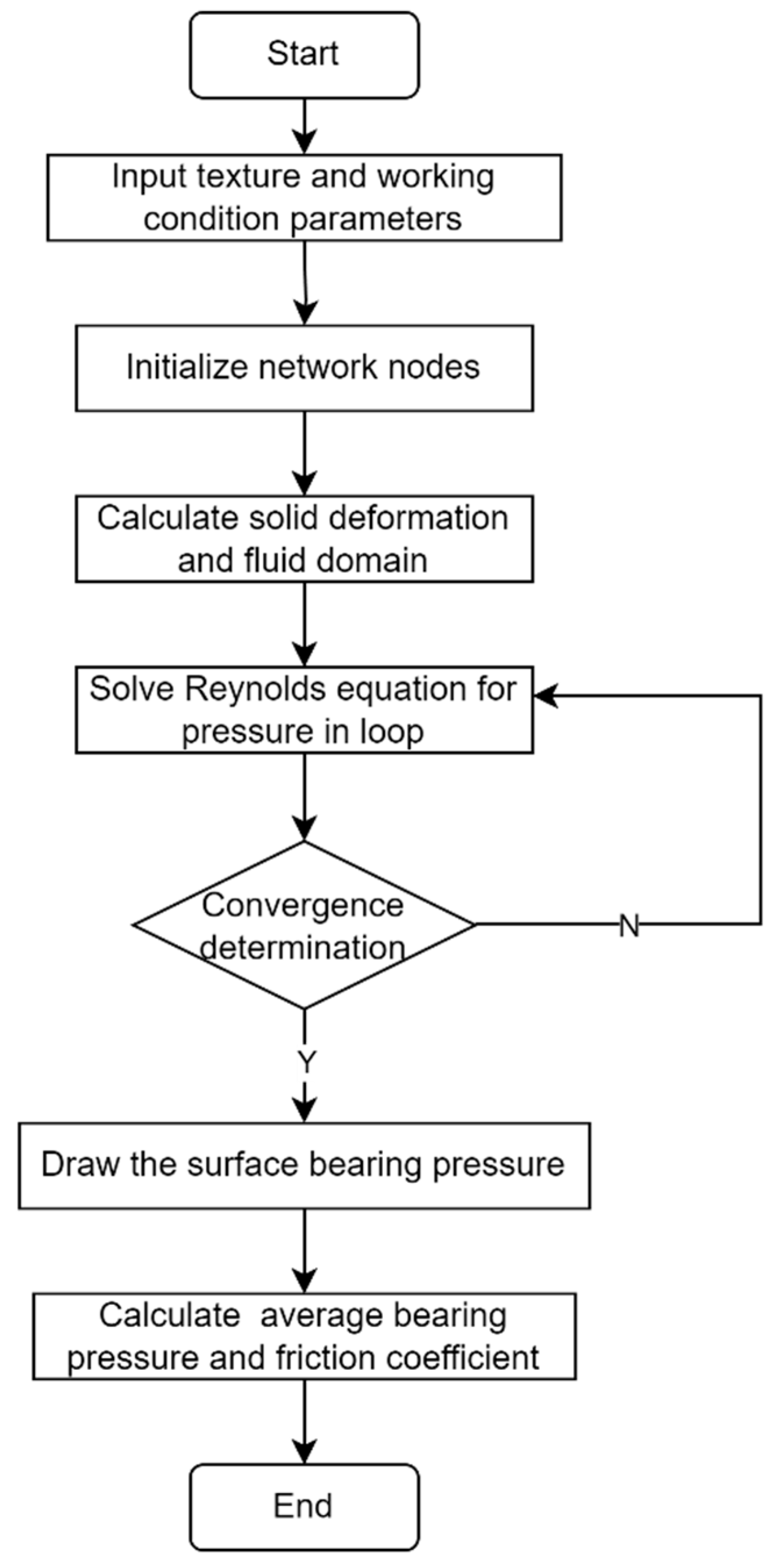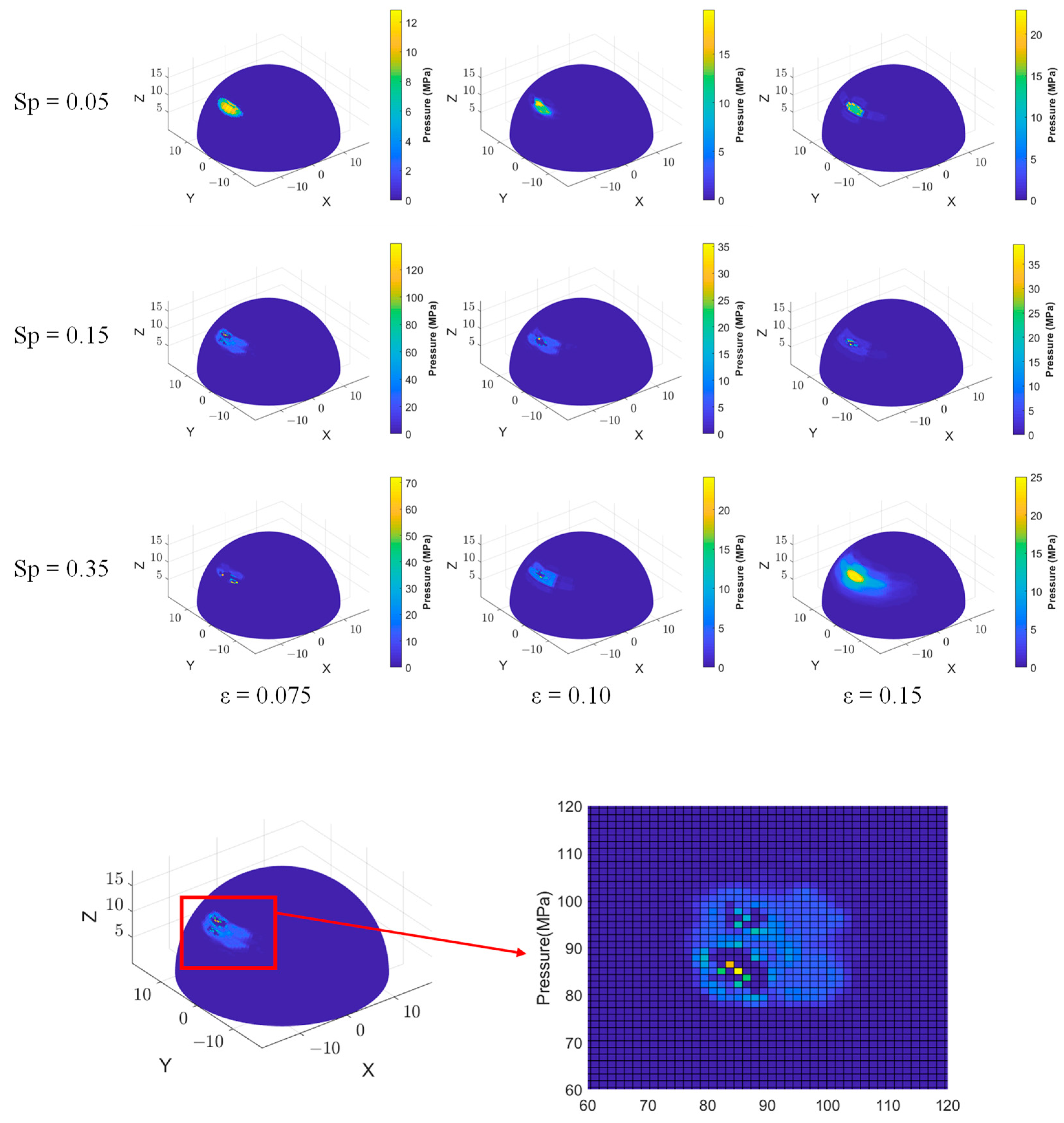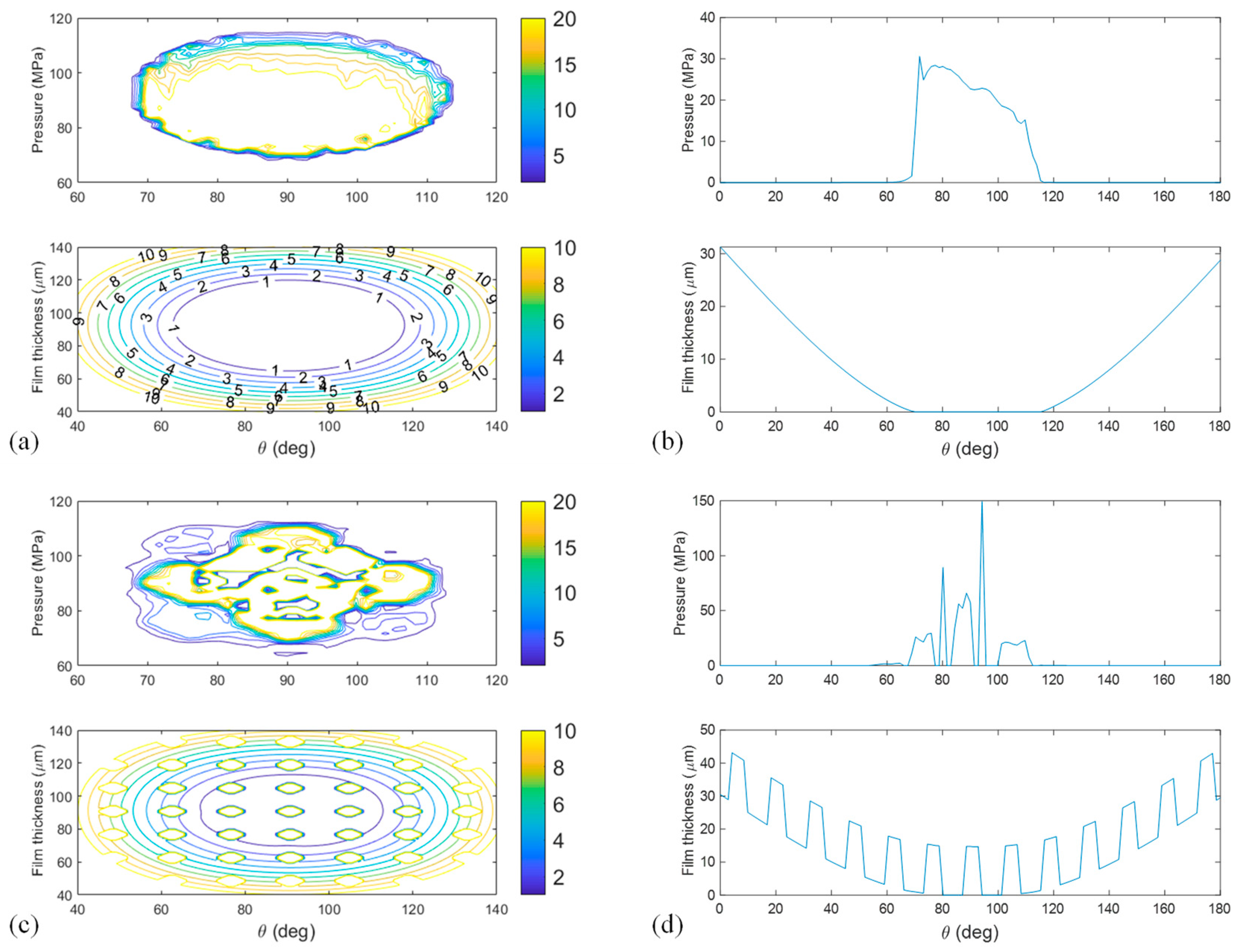Simulation Study on the Surface Texturing Design of COC Hip Joints Based on Elastohydrodynamic Lubrication Model
Abstract
1. Introduction
2. Methods
2.1. Materials
2.2. Establishing Hip Joint EHL Model
2.3. Construct the Film Thickness Field with Texture
2.4. Solving the Reynolds Equation
3. Results
4. Discussion
5. Conclusions
- Within the range of aspect ratio from 0.075 to 0.15, the average bearing capacity of the fluid film shows a tendency to increase with the increase in aspect ratio, and the changing trend of the friction coefficient is the same as that of the average bearing capacity. The friction coefficient is lowest when .
- Within the range of density from 0.05 to 0.35, with the increase in texture density, the average bearing capacity of the fluid film first decreases and then increases, while the friction coefficient also increases accordingly.
- The fuzzy comprehensive evaluation found that the textured structure with a density of 0.15 and an aspect ratio of 0.075 is the local optimal solution for improving lubrication and wear resistance, and the density can affect the surface wear resistance to a greater extent.
- Although the lubrication mechanism of the texture changes when the aspect ratio is greater than 0.1, considering that the amount of wear generated by ceramic hip joints is much lower than that of other materials, it is recommended to adopt the texture design with an aspect ratio of less than 0.1.
Author Contributions
Funding
Data Availability Statement
Conflicts of Interest
References
- Badarudeen, S.; Shu, A.C.; Ong, K.L.; Baykal, D.; Lau, E.; Malkani, A.L. Complications After Revision Total Hip Arthroplasty in the Medicare Population. J. Arthroplast. 2017, 32, 1954–1958. [Google Scholar] [CrossRef] [PubMed]
- Gundtoft, P.; Varnum, C.; Pedersen, A.B.; Overgaard, S. The Danish Hip Arthroplasty Register. CLEP 2016, 8, 509–514. [Google Scholar] [CrossRef] [PubMed]
- Gwam, C.U.; Mistry, J.B.; Mohamed, N.S.; Thomas, M.; Bigart, K.C.; Mont, M.A.; Delanois, R.E. Current Epidemiology of Revision Total Hip Arthroplasty in the United States: National Inpatient Sample 2009 to 2013. J. Arthroplast. 2017, 32, 2088–2092. [Google Scholar] [CrossRef] [PubMed]
- Neumann, D.R.P.; Thaler, C.; Hitzl, W.; Huber, M.; Hofstädter, T.; Dorn, U. Long-Term Results of a Contemporary Metal-on-Metal Total Hip Arthroplasty: A 10-Year Follow-Up Study. J. Arthroplast. 2010, 25, 700–708. [Google Scholar] [CrossRef]
- Whang, P.; Cher, D.; Polly, D.; Frank, C.; Lockstadt, H.; Glaser, J.; Limoni, R.; Sembrano, J. Sacroiliac Joint Fusion Using Triangular Titanium Implants vs. Non-Surgical Management: Six-Month Outcomes from a Prospective Randomized Controlled Trial. Int. J. Spine Surg. 2015, 9, 6. [Google Scholar] [CrossRef]
- Abdel Hameed, R.M.; Medany, S.S. Influence of Support Material on the Electrocatalytic Activity of Nickel Oxide Nanoparticles for Urea Electro-Oxidation Reaction. J. Colloid Interface Sci. 2018, 513, 536–548. [Google Scholar] [CrossRef]
- Pezzotti, G.; Saito, T.; Padeletti, G.; Cossari, P.; Yamamoto, K. Nano-Scale Topography of Bearing Surface in Advanced Alumina/Zirconia Hip Joint before and after Severe Exposure in Water Vapor Environment. J. Orthop. Res. 2010, 28, 762–766. [Google Scholar] [CrossRef]
- Perrichon, A.; Reynard, B.; Gremillard, L.; Chevalier, J.; Farizon, F.; Geringer, J. A Testing Protocol Combining Shocks, Hydrothermal Ageing and Friction, Applied to Zirconia Toughened Alumina (ZTA) Hip Implants. J. Mech. Behav. Biomed. Mater. 2017, 65, 600–608. [Google Scholar] [CrossRef]
- Imbuldeniya, A.M.; Pearce, S.J.; Walter, W.L.; Zicat, B.A.; Walter, W.K. Squeaking: Current Knowledge and How to Avoid It. Curr. Rev. Musculoskelet. Med. 2013, 6, 342–349. [Google Scholar] [CrossRef]
- Levy, Y.D. Review on Squeaking Hips. WJO 2015, 6, 812. [Google Scholar] [CrossRef]
- Walter, W.L.; Kurtz, S.M.; Esposito, C.; Hozack, W.; Holley, K.G.; Garino, J.P.; Tuke, M.A. Retrieval Analysis of Squeaking Alumina Ceramic-on-Ceramic Bearings. J. Bone Jt. Surg. Br. Vol. 2011, 93-B, 1597–1601. [Google Scholar] [CrossRef] [PubMed]
- Sugihara, T.; Enomoto, T. Performance of Cutting Tools with Dimple Textured Surfaces: A Comparative Study of Different Texture Patterns. Precis. Eng. 2017, 49, 52–60. [Google Scholar] [CrossRef]
- Niu, Y.; Hao, X.; Xia, A.; Wang, L.; Liu, Q.; Li, L.; He, N. Effects of Textured Surfaces on the Properties of Hydrodynamic Bearing. Int. J. Adv. Manuf. Technol. 2022, 118, 1589–1596. [Google Scholar] [CrossRef]
- Gavrilov, K.; Rozhdestvenskii, Y.; Umurzakov, I. A Method for Mathematical Modeling of Hydrodynamic Friction of Plunger Pairs with Consideration of Microgeometry. Mathematics 2023, 11, 2637. [Google Scholar] [CrossRef]
- Chen, T.; Ji, J.; Fu, Y.; Yang, X.; Fu, H.; Fang, L. Tribological Performance of UV Picosecond Laser Multi-Scale Composite Textures for C/SiC Mechanical Seals: Theoretical Analysis and Experimental Verification. Ceram. Int. 2021, 47, 23162–23180. [Google Scholar] [CrossRef]
- Allen, Q.; Raeymaekers, B. Surface Texturing of Prosthetic Hip Implant Bearing Surfaces: A Review. J. Tribol. 2021, 143, 040801. [Google Scholar] [CrossRef]
- Roy, T.; Choudhury, D.; Ghosh, S.; Bin Mamat, A.; Pingguan-Murphy, B. Improved Friction and Wear Performance of Micro Dimpled Ceramic-on-Ceramic Interface for Hip Joint Arthroplasty. Ceram. Int. 2015, 41, 681–690. [Google Scholar] [CrossRef]
- Han, Z.; Ma, L.; Yu, X.; Li, H.; Jiang, H. Numerical Simulation and Experimental Investigation on the Friction Reduction Properties of ZrO₂ by Laser Surface Texture. Appl. Phys. A 2024, 130, 64. [Google Scholar] [CrossRef]
- Zou, H.; Yan, S.; Shen, T.; Wang, H.; Li, Y.; Chen, J.; Meng, Y.; Men, S.; Zhang, Z.; Sui, T.; et al. Efficiency of Surface Texturing in the Reducing of Wear for Tests Starting with Initial Point Contact. Wear 2021, 482–483, 203957. [Google Scholar] [CrossRef]
- Hao, J.; Zhang, Q.; Zhang, C. Study on Tribological Properties of Artificial Hip Textured Surface. Lubr. Eng. 2023, 48, 55–61. [Google Scholar] [CrossRef]
- Choudhury, D.; Ay Ching, H.; Mamat, A.B.; Cizek, J.; Abu Osman, N.A.; Vrbka, M.; Hartl, M.; Krupka, I. Fabrication and Characterization of DLC Coated Microdimples on Hip Prosthesis Heads. J. Biomed. Mater. Res. 2015, 103, 1002–1012. [Google Scholar] [CrossRef] [PubMed]
- Gao, L.; Hua, Z.; Hewson, R. Can a “Pre-Worn” Bearing Surface Geometry Reduce the Wear of Metal-on-Metal Hip Replacements?—A Numerical Wear Simulation Study. Wear 2018, 406–407, 13–21. [Google Scholar] [CrossRef]
- Mourier, L.; Mazuyer, D.; Lubrecht, A.A.; Donnet, C. Transient Increase of Film Thickness in Micro-Textured EHL Contacts. Tribol. Int. 2006, 39, 1745–1756. [Google Scholar] [CrossRef]
- Zheng, Q.; Mao, L.; Shi, Y.; Zhang, C.; Hu, Y. Analysis of Biomimetic Texture Surface on Dynamic Compression Lubrication and Friction Reduction of Artificial Hip Pair. J. Mech. Eng. 2021, 57, 102. [Google Scholar] [CrossRef]
- Calonius, O.; Saikko, V. Slide Track Analysis of Eight Contemporary Hip Simulator Designs. J. Biomech. 2002, 35, 1439–1450. [Google Scholar] [CrossRef]
- Fisher, J.; Jin, Z.; Tipper, J.; Stone, M.; Ingham, E. Tribology of Alternative Bearings. Clin. Orthop. Relat. Res. 2006, 453, 25–34. [Google Scholar] [CrossRef]
- Gao, L. 16—Lubrication Modelling of Hip Joint Implants. In Computational Modelling of Biomechanics and Biotribology in the Musculoskeletal System, 2nd ed.; Jin, Z., Li, J., Chen, Z., Eds.; Woodhead Publishing Series in Biomaterials; Woodhead Publishing: Cambridge, UK, 2021; pp. 415–436. ISBN 978-0-12-819531-4. [Google Scholar]
- Gao, L.; Dowson, D.; Hewson, R.W. Predictive Wear Modeling of the Articulating Metal-on-Metal Hip Replacements. J. Biomed. Mater. Res. Part B Appl. Biomater. 2017, 105, 497–506. [Google Scholar] [CrossRef]
- Tewelde, F.B.; Allen, Q.; Zhou, T. Multiscale Texture Features to Enhance Lubricant Film Thickness for Prosthetic Hip Implant Bearing Surfaces. Lubricants 2024, 12, 187. [Google Scholar] [CrossRef]
- Niemczewska-Wójcik, M. Wear Mechanisms and Surface Topography of Artificial Hip Joint Components at the Subsequent Stages of Tribological Tests. Measurement 2017, 107, 89–98. [Google Scholar] [CrossRef]
- Zhang, H.; Hua, M.; Dong, G.; Zhang, D.; Chin, K.-S. A Mixed Lubrication Model for Studying Tribological Behaviors of Surface Texturing. Tribol. Int. 2016, 93, 583–592. [Google Scholar] [CrossRef]
- Codrignani, A.; Savio, D.; Pastewka, L.; Frohnapfel, B.; van Ostayen, R. Optimization of Surface Textures in Hydrodynamic Lubrication through the Adjoint Method. Tribol. Int. 2020, 148, 106352. [Google Scholar] [CrossRef]
- Allen, Q.; Raeymaekers, B. Maximizing the Lubricant Film Thickness Between a Rigid Microtextured and a Smooth Deformable Surface in Relative Motion, Using a Soft Elasto-Hydrodynamic Lubrication Model. J. Tribol. 2020, 142. [Google Scholar] [CrossRef] [PubMed]
- Křupka, I.; Hartl, M. Effect of Surface Texturing on Very Thin Film EHD Lubricated Contacts. Tribol. Trans. 2008, 52, 21–28. [Google Scholar] [CrossRef]
- Li, K.; Yao, Z.; Hu, Y.; Gu, W. Friction and Wear Performance of Laser Peen Textured Surface under Starved Lubrication. Tribol. Int. 2014, 77, 97–105. [Google Scholar] [CrossRef]
- Raeymaekers, B.; Etsion, I.; Talke, F.E. A Model for Magnetic Tape/Guide Friction Reduction by Laser Surface Texturing. Tribol. Lett. 2007, 28, 9–17. [Google Scholar] [CrossRef]










| Parameters | Value |
|---|---|
| Sphere Radius | 18 mm |
| Texturing Depth | 0.03 mm |
| Elastic modulus | 380 GPa |
| Dynamic Viscosity | 0.0009 Pa·s |
| Dimple Diameter | 0.2/0.3/0.4 mm |
| Dimple Density | 0.05/0.15/0.35 |
| Texture Parameters | Average Bearing Pressure/MPa | Friction Coefficient | Membership Degree | |
|---|---|---|---|---|
| Smooth | 28.94 | 0.013 | / | |
| Sp = 0.05 | ε = 0.075 | 46.74 | 0.0025 | 0.4912 |
| Sp = 0.05 | ε = 0.1 | 169.71 | 0.0016 | 0.4737 |
| Sp = 0.05 | ε = 0.15 | 143.46 | 0.0014 | 0.5922 |
| Sp = 0.15 | ε = 0.075 | 63.36 | 0.0029 | 0.9462 |
| Sp = 0.15 | ε = 0.1 | 62.21 | 0.0037 | 0.3994 |
| Sp = 0.15 | ε = 0.15 | 111.98 | 0.0055 | 0.3442 |
| Sp = 0.35 | ε = 0.075 | 69.77 | 0.0024 | 0.8886 |
| Sp = 0.35 | ε = 0.1 | 53.41 | 0.0036 | 0.3994 |
| Sp = 0.35 | ε = 0.15 | 184.56 | 0.0078 | 0.4248 |
| Level | Aspect Radio | Density |
|---|---|---|
| 1 | 0.002596 | 0.001830 |
| 2 | 0.002960 | 0.004005 |
| 3 | 0.004875 | 0.004595 |
| Patch | 2 | 1 |
Disclaimer/Publisher’s Note: The statements, opinions and data contained in all publications are solely those of the individual author(s) and contributor(s) and not of MDPI and/or the editor(s). MDPI and/or the editor(s) disclaim responsibility for any injury to people or property resulting from any ideas, methods, instructions or products referred to in the content. |
© 2025 by the authors. Licensee MDPI, Basel, Switzerland. This article is an open access article distributed under the terms and conditions of the Creative Commons Attribution (CC BY) license (https://creativecommons.org/licenses/by/4.0/).
Share and Cite
Wu, Z.; Gao, L.; Huang, X.; Hua, Z. Simulation Study on the Surface Texturing Design of COC Hip Joints Based on Elastohydrodynamic Lubrication Model. Lubricants 2025, 13, 217. https://doi.org/10.3390/lubricants13050217
Wu Z, Gao L, Huang X, Hua Z. Simulation Study on the Surface Texturing Design of COC Hip Joints Based on Elastohydrodynamic Lubrication Model. Lubricants. 2025; 13(5):217. https://doi.org/10.3390/lubricants13050217
Chicago/Turabian StyleWu, Zhenxing, Leiming Gao, Xiuling Huang, and Zikai Hua. 2025. "Simulation Study on the Surface Texturing Design of COC Hip Joints Based on Elastohydrodynamic Lubrication Model" Lubricants 13, no. 5: 217. https://doi.org/10.3390/lubricants13050217
APA StyleWu, Z., Gao, L., Huang, X., & Hua, Z. (2025). Simulation Study on the Surface Texturing Design of COC Hip Joints Based on Elastohydrodynamic Lubrication Model. Lubricants, 13(5), 217. https://doi.org/10.3390/lubricants13050217





